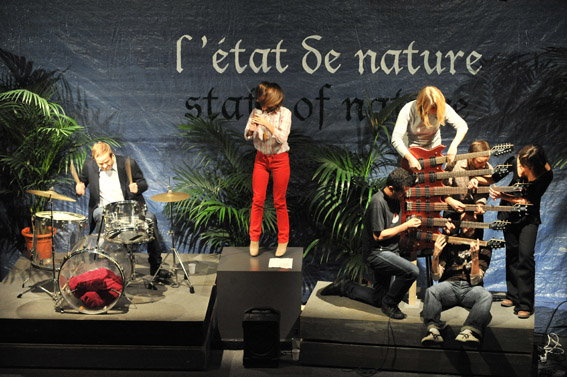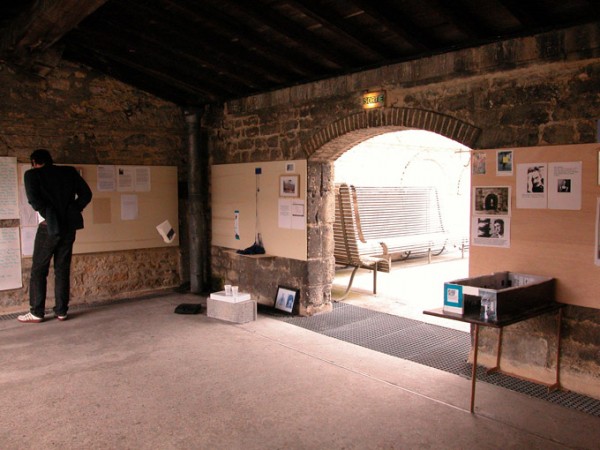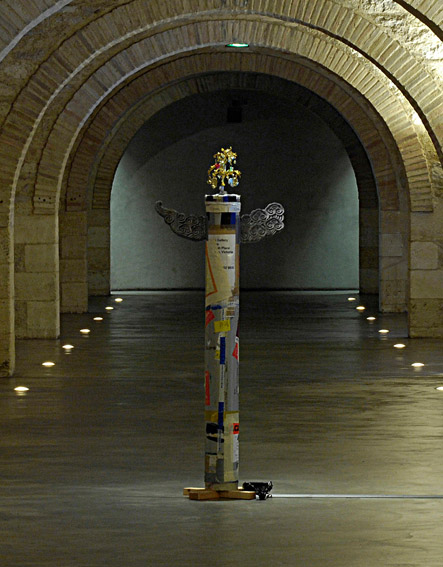A Constructed World

Like a chicken in front of a knife? Maybe, but never lost in translation!
A Constructed World ? What the hell does it mean ? S’agirait-il d’un de ces slogans politiques péremptoires savamment relevé d’un zeste d’utopisme, du nom fanfaronnant de quelque ambitieux programme de développement urbain, du titre d’un album de Krautrock ou pourquoi pas encore d’un nouveau label qualité ? Effectivement, le patronyme choisi par le duo d’artistes australiens Jacqueline Riva et Geoff Lowe sonne un peu comme tout ça à la fois, dans un jonglage malicieux et amusé entre universalisme, programmatique, analyse théorique et humour typiquement anglo-saxon. Leur « monde construit » est un réseau au sens où l’entend Bruno Latour, une combinaison relationniste dynamique entre les humains et les non humains (les choses) qui agissent en médiateurs ou intermédiaires les uns avec les autres. En regardeurs acerbes de notre condition sociétale, ils entreprennent depuis plus de quinze ans la critique d’un sens commun par la mise en synergie et en perspective des expériences de chacun. Ainsi, comme une nouvelle pierre apportée à l’édifice, chaque exposition, workshop ou projet est prétexte à faire émerger le sens dans l’implication du public et des éléments qui composent la situation dans laquelle les artistes sont amenés à intervenir.
Invité à investir le Capc de Bordeaux pendant un an, A Constructed World réfute la logique d’unité de temps et d’espace qu’implique traditionnellement le médium de l’exposition pour lui objecter une analyse en règle du musée. Ce dernier est alors vu comme un tout organique né de la conjugaison d’activités humaines et de données contextuelles. Le projet Saisons Increase vient questionner l’institution muséale, son statut et ses limites en s’imposant à elle au cœur de son activité autant que dans ses marges. Ici et là, les œuvres viennent ponctuer les lieux de passages, oubliés ou invisibles, provoquer des points de vue alternatifs, imposer à l’architecture de nouvelles zones de tensions par la circulation et inventer des espaces sociaux insolites au sein du musée par la relecture de son existence. Les deux artistes se sont notamment arrêtés sur un épisode noir de son histoire, aussi connu que tabou aux yeux des bordelais : la défenestration d’un visiteur dans la nef. À proximité immédiate de l’endroit où la tragédie eut lieu, A Constructed World installe son Suicide Shrine – littéralement « mémorial du suicide » – sur lequel chacun est invité à placer un objet, un texte, une image évoquant le suicide ou la perte d’un proche. L’idée est ainsi d’utiliser un espace du musée dans sa vocation sociale qui dépasse de loin la stricte sphère de l’art et d’offrir aux familles confrontées à la douleur d’une disparition forcément brutale l’opportunité d’envisager le deuil dans une perspective collective.

Suicide Shrine, 2008. Bois, impressions jet d'encre sur papier, tirages photographiques, Post-it, livres, cadres, lecteur de cassettes audio, lampe, dimensions variables. Photo: juin 2008.
A Constructed World appréhende ainsi le travail artistique autant que la manière dont celui-ci est appréhendé dans son contexte. Chaque action, chaque œuvre proposée trouve sa validité dans un aller-retour constructif entre experts et amateurs sans hiérarchie ni système de valeur. « No need to be great », prônent-ils ! Cette assertion résonne comme l’adage fédérateur du think tank loufoque et décomplexé auquel nous convient ces généreux adeptes du sens collectif et de la mise à mal des conventions esthétiques. Pour eux, ce qui fait l’œuvre et sa valeur, c’est l’association, la formation, l’ensemble des relations et les médiations qui les font exister ensemble. Tout se trouve alors être d’égale importance pour l’analyse, qu’il s’agisse des facteurs organisationnels, cognitifs, discursifs ou des entités objectales qui entrent dans la composition de ces collectifs. Leur approche ne fait ainsi sens qu’en qualité de lieu de la collaboration et de l’échange entre spécialistes et amateurs pour une construction commune du discours. Héritier de la revue collaborative Artfan publiée dans les années 1990, le projet en cours Speech, a site for reviews interviews projects and your comments, par exemple, est un blog participatif sur lequel chacun est invité à répondre par le verbe à un sujet donné, qu’il s’agisse d’une exposition en cours, d’un projet mené ou d’un document posté. Les artistes initient le discours sans jamais l’orienter. Et c’est dans l’accumulation des participations et des points de vue que s’élabore le propos.

Money Tree, 2006 (en collaboration avec Hao Guo). Cylindre de plastique, carton, impressions jet d'encre sur papier, vignettes autocollantes, moteur. 155 cm x 35 cm.
La dimension participative comme leitmotiv de la pratique artistique impose de fait le méandre et la pluralité des formes. La maxime prônée par notre Marcel bien-aimé « c’est le regardeur qui fait l’œuvre » prend chez eux une dimension spécifique et efficience parce que placée à un niveau pratique. Ici, « c’est le participant qui fait l’œuvre ». Ainsi, très logiquement, on ne connaît pas de réelle signature visuelle chez A Constructed World, mais bien des partis pris dont la multiplicité rend parfois déroutante la lecture de la démarche. Et le public de bien souvent se retrouver comme une poule devant un couteau, désarmé et interdit, bien à mal d’embrasser globalement un corpus si hétéroclite de vidéos, de dessins, d’installation, de textes, de performances. Bref, d’expériences fixées, évoquées ou vécues. Mais à la revendication d’une esthétique résolument insaisissable ou absconse, les deux Australiens préfèrent celle de la complexité du bordel philosophique où se conjuguent pêle-mêle les références à Thomas Hobbes, à Jacques Lacan ou à Jacques Derrida. « Increase your uncertainty », scandent-ils ! Charge à chacun ensuite d’y trouver son chemin en invoquant le processus de traduction pensé par Michel Serres. Pas d’interface linguistique ici, mais une opération de transformation qui établit un lien entre des activités profondément hétérogènes pour rendre le monde intelligible à la lumière de leur monde construit.
A Constructed World, Saisons Increase, part 1 : Ruisseler à rebours, au Capc de Bordeaux,
février à mai 2008
A Constructed World, Saisons Increase, part 2 : Temps fou, au Capc de Bordeaux,
juin à octobre 2008
A Constructed World, Saisons Increase, part 3 : L’hiver en été, l’été en hiver, au Capc de Bordeaux,
octobre à novembre 2008
A Constructed World, Saisons Increase, part 4 : L’art de bien gouverner, au Capc de Bordeaux,
décembre 2008 à février 2009
A Constructed World
Like a chicken in front of a knife? Maybe, but never lost in translation!
Par Etienne Bernard
A Constructed World? What the hell does that mean? Might it be one of those peremptory political slogans, penned in a flight of utopian zeal? The swaggering self-styling of some ambitious urban development plan? The title of a Krautrock album? Why not even a new seal of quality? The moniker chosen by the Australian artist duo of Jacqueline Riva and Geoff Loew sounds a bit like all of these at once–a smiling and malicious jumble of universalism, programmatics, theoretical analysis, and characteristically anglo-saxon humor.
Their « constructed world » is a network in the sense that Bruno Latour defines it, a dynamic relational matrix of humans and non-humans (or things), each acting as a mediator or intermediary between the others. Caustic critics of our societal condition, they have been waging a war against common sense for over fifteen years, setting our experiences in perspective and synergy with each other. Like a new stone added to the edifice, each exhibition, workshop, or project functions as a pretext for the discovery of meaning in the situation in which they have been asked to intervene, its implication of the public.
Invited to occupy the CAPC de Bordeaux over the space of one year, A Constructed World rejects the unity of time and space traditionally associated with the exhibition medium in favor of a methodical analysis of the museum. The latter is construed as an organic whole, born out of the intersection of human activities and contextual givens. The project Seasons Increase questions the institution of the museum–its status, its limits–, insinuating itself both at the heart of its activity and along its margins. Here and there, works punctuate the premises with small passageways–forgotten or invisible–incite alternative points of view, create new zones of tension in the architecture via circulation, invent unusual meeting spaces through a re-reading of the museum’s existence. The artists also hone in on a dark episode in the building’s history, both widely known and taboo among the city’s residents: the defenestration of a visitor in the nave. A Constructed World installs its Suicide Shrine in the immediate vicinity of the site where the tragedy took place, inviting visitors to place an object, a text, or an image evoking the suicide or the death of a loved one. Their rationale is to utilize the museum space for its social vocation, one that greatly eclipses its artistic one, and to offer families confronted with the brutal pain of loss the opportunity to envision the mourning process from a collective perspective.
A Consructed World comprises both artistic production and the manner in which the former is experienced in its context. Each action, each work establishes its validity in a constructive back-and-forth between experts and amateurs, devoid of hierarchy and value system. « No need to be great! » they insist. This statement emerges as the rallying cry for the unabashedly madcap think tank incarnated by these experts in collective meaning and the unsettling of aesthetic conventions. Here, works of art and their value are constituted through the association, the formation, and the ensemble of relations and mediations that enBLE them to co-exist. Everything is of equal importance in this incarnation of analysis, be it organizational factors, cognitive or discursive ones, or the objective entities that go into the composition of these collectivities. The task of the artist becomes that of creating a site for collaboration and exchange between specialists and amateurs in the construction of a communal discourse. The ongoing web project Speech: a site for reviews interviews projects and your comments, the heir to the collaborative magazine Artfan (published in the 1990s), is a participative blog that invites visitors to respond to a given subject– be it an exhibition in progress, a completed project, or a posted document. The artists initiate discourse without ever directing it, allowing the content of the blog to elaborate itself through an accumulation of participations.
This participative dimension–a leitmotif in Jacqueline Riva and Geoff Loew’s practice–engenders a meandering and plurality of form. Through its practical application, the maxim repeated by our beloved Marcel– « it’s the viewer who makes the work of art »–takes on a novel specificity and effectiveness. Here, « it is the participant who makes the work. » As a logical result, A Constructed World lacks a recognizable visual signature; what we discover in its place is an accumulation of artistic choices whose sheer multiplicity makes it difficult to navigate. Their public begins to feel kind of like a chicken under a knife: shocked, disarmed, hard pressed to assimilate such a miscellaneous corpus of videos, drawings, installations, texts, performances–in short, of experiences configured, evoked, and lived. But the artists’ commitment to a complex philosophical chaos–this anarchic crossbreeding of references to Thomas Hobbes, Jacques Lacan, and Jacques Derrida–comes before their affinity for such a resolutely abstruse and elusive aesthetic. « Increase your uncertainty! » they cheer. We are left with the task of finding our own path through this constellation, engaging in the process of translation as Michel Serres once defined it–not a navigation of a linguistic interface, but a transformative operation establishing links between profoundly heterogenous activities. Our world becomes intelligible in the light of this constructed world.
A Constructed World, Saisons Increase, Part 1 : Ruisseler à rebours, at the CAPC de Bordeaux,
Feburary to May, 2008
A Constructed World, Saisons Increase, part 2 : Temps fou, at the CAPC de Bordeaux,
June to October, 2008
A Constructed World, Saisons Increase, part 3 : L’hiver en été, l’été en hiver, at the CAPC de Bordeaux,
October to November, 2008
A Constructed World, Saisons Increase, part 4 : L’art de bien gouverner, at the CAPC de Bordeaux,
December 2008 to February 2009
- Partage : ,
- Du même auteur : Pauline Bastard, Walead Beshty, Gyan Panchal, Geologically different ,
articles liés
Gregory Sholette
par Ingrid Luquet-Gad
Vera Kox
par Mya Finbow
Agnieszka Kurant
par Sarah Matia Pasqualetti

